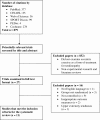Does eccentric exercise reduce pain and improve strength in physically active adults with symptomatic lower extremity tendinosis? A systematic review
- PMID: 18059998
- PMCID: PMC1978463
Does eccentric exercise reduce pain and improve strength in physically active adults with symptomatic lower extremity tendinosis? A systematic review
Abstract
Objective: To critically review evidence for the effectiveness of eccentric exercise to treat lower extremity tendinoses.
Data sources: Databases used to locate randomized controlled trials (RCTs) included PubMed (1980-2006), CINAHL (1982-2006), Web of Science (1995-2006), SPORT Discus (1980-2006), Physiotherapy Evidence Database (PEDro), and the Cochrane Collaboration Database. Key words included tendon, tendonitis, tendinosis, tendinopathy, exercise, eccentric, rehabilitation, and therapy.
Study selection: The criteria for trial selection were (1) the literature was written in English, (2) the research design was an RCT, (3) the study participants were adults with a clinical diagnosis of tendinosis, (4) the outcome measures included pain or strength, and (5) eccentric exercise was used to treat lower extremity tendinosis.
Data extraction: Specific data were abstracted from the RCTs, including eccentric exercise protocol, adjunctive treatments, concurrent physical activity, and treatment outcome.
Data synthesis: The calculated post hoc statistical power of the selected studies (n = 11) was low, and the average methodologic score was 5.3/10 based on PEDro criteria. Eccentric exercise was compared with no treatment (n = 1), concentric exercise (n = 5), an alternative eccentric exercise protocol (n = 1), stretching (n = 2), night splinting (n = 1), and physical agents (n = 1). In most trials, tendinosis-related pain was reduced with eccentric exercise over time, but only in 3 studies did eccentric exercise decrease pain relative to the control treatment. Similarly, the RCTs demonstrated that strength-related measures improved over time, but none revealed significant differences relative to the control treatment. Based on the best evidence available, it appears that eccentric exercise may reduce pain and improve strength in lower extremity tendinoses, but whether eccentric exercise is more effective than other forms of therapeutic exercise for the resolution of tendinosis symptoms remains questionable.
Keywords: Achilles tendon; patellar tendon; rehabilitation; tendon.
Figures
References
-
- Jarvinen M, Jozsa L, Kannus P, Jarvinen TL, Kvist M, Leadbetter W. Histopathological findings in chronic tendon disorders. Scand J Med Sci Sports. 1997;7:86–95. - PubMed
-
- Case and Demographic Characteristics for Work-Related Injuries and Illnesses Involving Days Away From Work. Washington, DC: US Department of Labor, Bureau of Labor Statistics; 2003.
-
- James SL, Bates BT, Osternig LR. Injuries to runners. Am J Sports Med. 1978;6:40–50. - PubMed
-
- Kvist M. Achilles tendon injuries in athletes. Ann Chir Gynaecol. 1991;80:188–201. - PubMed
-
- Lian OB, Engebretsen L, Bahr R. Prevalence of jumper's knee among elite athletes from different sports: a cross-sectional study. Am J Sports Med. 2005;33:561–567. - PubMed
Publication types
MeSH terms
LinkOut - more resources
Full Text Sources
Medical

